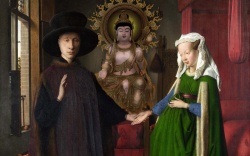Buddhist Tantric Tradition
As a method in Buddhism, the objective is enlightenment "in this very lifetime," but in both traditions, Hindu and Buddhist, it is acknowledged that the path of tantra is a risky one, indeed.
In a well-known warning given by master to student, he or she who embarks upon the tantric path may be compared to a small snake inside a hollow bamboo tube. That is, once you get in there are only two ways out -- up to enlightenment, or down to hell.
There has also been some misunderstandings about the nature and role of Buddhist teachers, generally. It is not necessary to be a celibate monk in order to mentor others on the Buddhist path. Many married people are also disciplined practitioners of meditation and other tantric techniques. Many others have partners or consorts with whom they work towards achieving the highest realization.
Buddhist tantric practitioners, ngakpas -- they are not monks -- generally do not take a consort until they are middle-aged when their meditation and other practices are stable. Crazy Wisdom
There is in the Buddhist Mahayana tradition, a long and respected tradition of the enlightened teacher who, according to general social norms, may appear to be very eccentric. But that is not to say that if a teacher behaves in an improper way towards a student, he or she ought to be excused as a "crazy yogi." There is no excuse for the abuse of power or the manipulation of those who are vulnerable and trusting.
Students, too, must be careful, as it will surely result in very bad karmic consequences to cause any ordained teacher, celibate or not, to break their vows. Magic
The word magic means "activity that the mages of Persia (and other Easter lands) were known for." They bedazzled their audiences by seeming to be able to transform one thing into another. As with other skills or arts of human beings, we can only know what they accomplished long ago once their deeds were recorded for posterity by means of the written word. It is highly likely that many ancient practices were never written down.
The 20th-century saw a revival of the European expression of this training (to practice transformation by extraordinary means) in Wicca. Wicca is a Norse word that is related to wicker [wic > vik = to bend] the product of skill, training and imagination where witheys [thin willow branches] are bent, braided or twisted to form baskets and other useful objects. The word for any work of this kind is craft, as in arts and crafts. A crafter of wicker objects was called a wicca or wicce [f. form, pron. witch.] Hence the northern European "tantric" tradition is called Witchcraft.
Of course, we know that the word witch took on another meaning entirely, so that today, people who do self-transformative practices in the European tradition are often reluctant to to use that expression.
Because of the terrible persecution inflicted upon anyone suspected of following the early European wisdom traditions, intact ancient lineages do not exist any longer. Today, the western rituals and practices stem mainly from 19th-century Britain, though there are some others. The same is true of the West African traditions that came to the West as Macumba and Vaudun (voodoo) Therefore, sadly there are very few genuine, intact tantric traditions still remaining.

